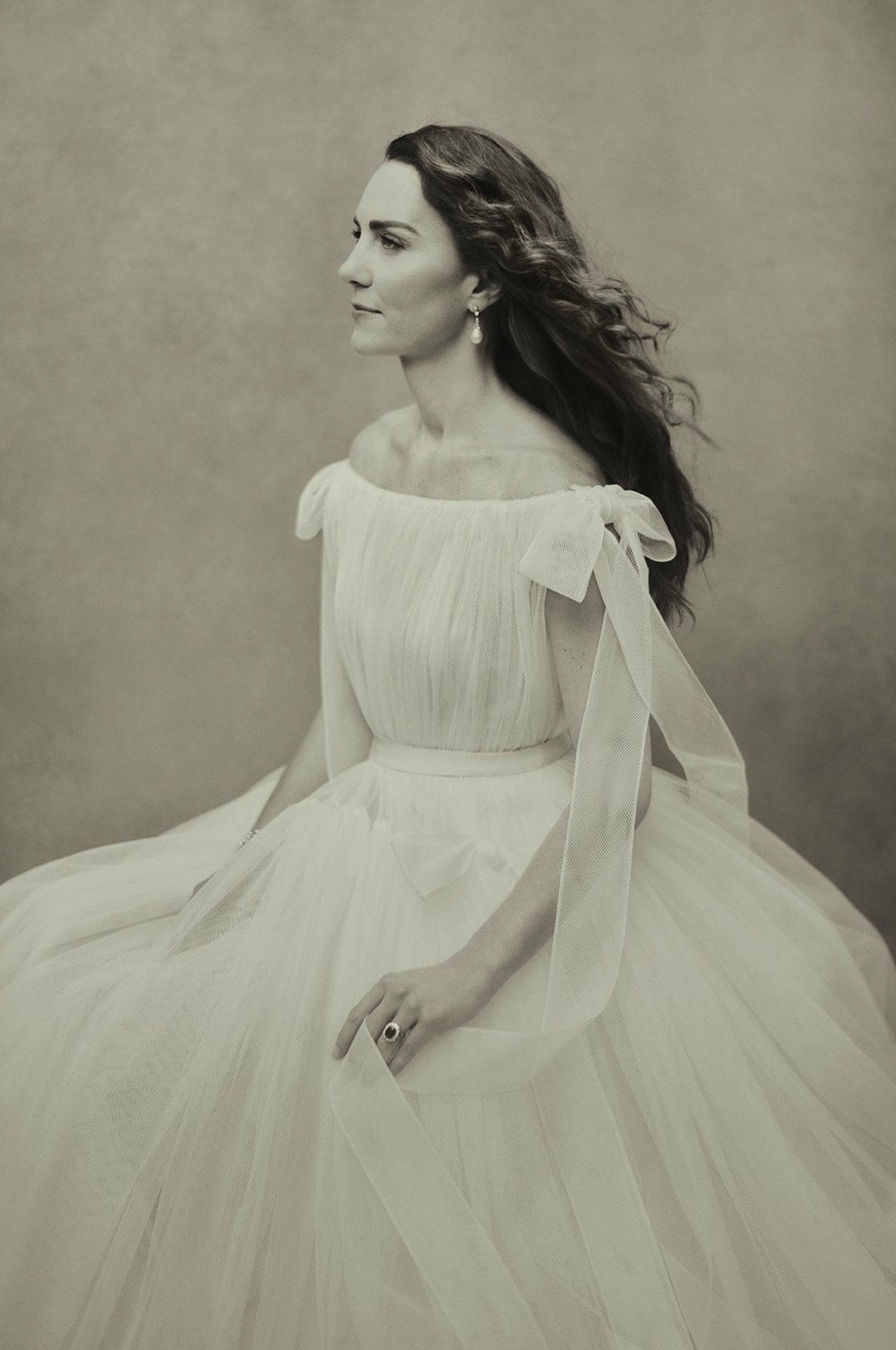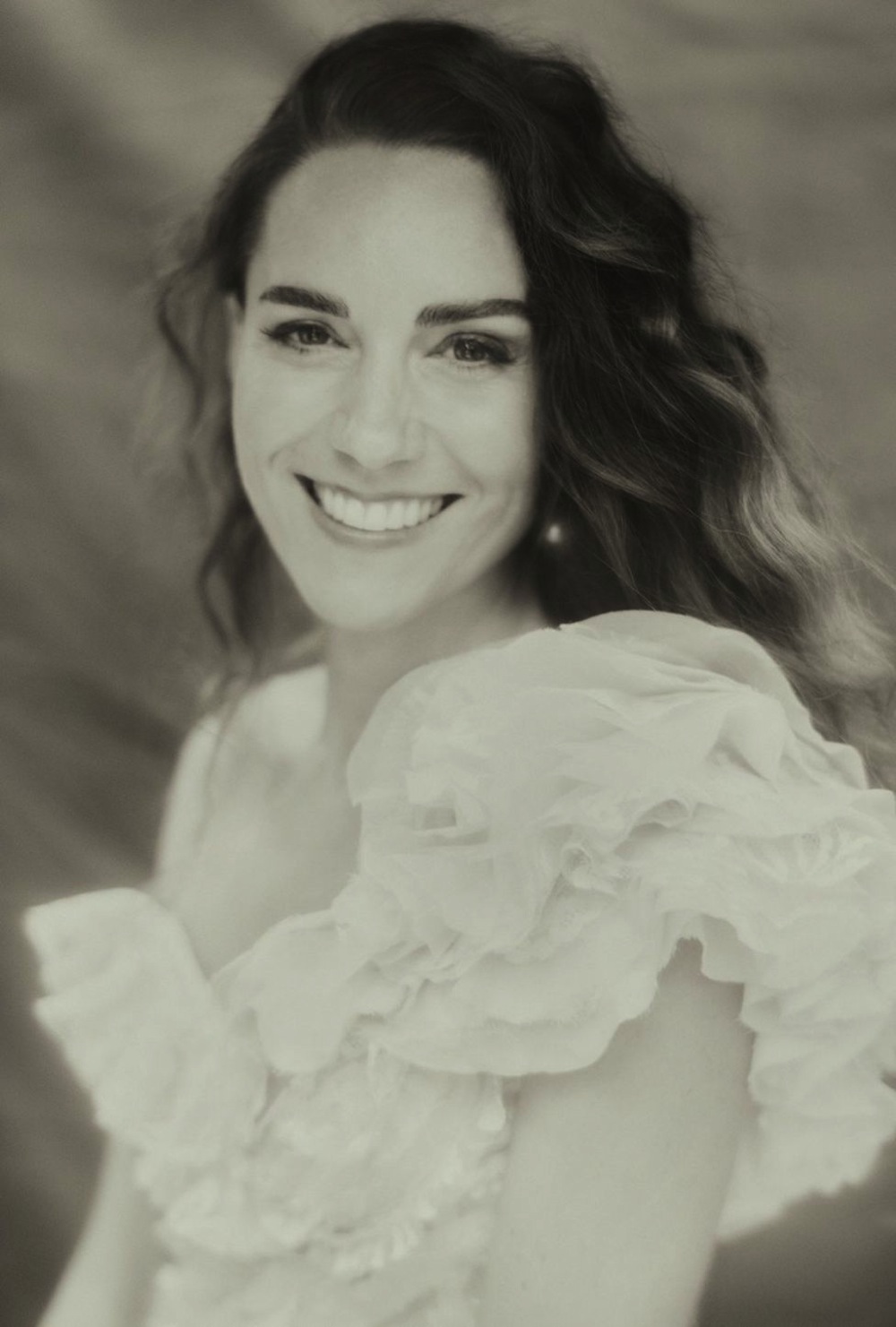In an interview with the Italian daily newspaper Corriere della Sera Italian fashion photographer Paolo Roversi has revealed the inside story of the three photographic portraits of The Duchess of Cambridge that were released on 9 January 2022 to mark Her Royal Highness’s 40th birthday.
The photographs were shot in natural light at Kew Gardens, London, and picture the Duchess in three different Alexander McQueen dresses, as well as earrings belonging to The Queen and the late Princess Diana. They will feature as part of the National Portrait Gallery’s (NPG) ‘Coming Home’ project – it’s a nationwide initiative, which sees portraits from the NPG Collection of well-known individuals being sent and shown at locations across the UK which they are closely associated with.
Coming Home displays
During 2022 the images of the Duchess will be displayed in three places that have special meaning to her: Berkshire (where she grew up), St. Andrews (where she went to university and met Prince William) and Anglesey (where she lived following her 2011 marriage to Prince William). Exact details on where and when each portrait will be shown as part of the Coming Home project will be announced by the NPG in due course. Previous photographic portraits in the Coming Home series have depicted footballer David Beckham, Olympic athlete Dame Jessica Ennis-Hill, actor Maxine Peake, grime superstar Stormzy and film director Ridley Scott.
Paolo Roversi is an Italian fashion photographer who began his career as a photojournalist with Associated Press but has worked and lived in Paris since 1973, since being approached to work by Elle magazine’s then artistic director, Peter Knapp. In 1974 he worked as an assistant to British photographer Laurence Sackman (d. 2020) and has since built an international reputation for his iconic portraits of celebrities including Sting, Madonna, Naomi Campbell, Kate Moss, Saoirse Ronan, Kristen Stewart and Rihanna. His distinctive images have often been compared to the work of 19th century photographers such as Julia Margaret Cameron and Camille Silvy, his pictures are held in several major collections (including the NPG’s) and have been exhibited all around the world.

The colour portrait by Paolo Roversi released to mark the 40th birthday of the Duchess of Cambridge. Image: Paolo Roversi/Kensington Palace via Getty Images
Discussing the photos he’d taken of the Duchess of Cambridge, Roversi revealed, ‘Taking the portrait of Her Royal Highness, the Duchess of Cambridge, was a true honour for me, and a moment of pure joy. I was moved by her warmth and friendly welcome and enchanted by her shining eyes that reflected the loveliness of her soul and her smile showing the generosity of her heart. It was a profound and rich experience for me, an unforgettable moment. I have met a wonderful person, a person who, with her positive energy, can bring hope to the whole world.’
It’s believed that Roversi had several video call meetings with the Duchess and then had a first face-to-face meeting in November 2021 at Kensington Palace, for tea and biscuits, before the shoot at Kew Gardens. He told Corriere della Sera, ‘[it was] a nice meeting, and then some nice photos. But at first the Duchess was apprehensive. Every day she is “machine-gunned” by photographers but not used to posing; knowing my photos with the models, she was a little fearful in facing a real session, which then required about four hours of work. I reassured her that once it started it would be very easy, and so it was. ate, who also studied art in Florence, is very fond of photography, in particular of authors such as Julia Margaret Cameron and Lewis Carroll who wrote Alice in Wonderland.’
Camera choices
It has not yet been revealed exactly which cameras Roversi used for the shoot with the Duchess of Cambridge but he is known to work with large format cameras such as a 10×8 Deardorff, was among the first to use one of the famous 20×24 Polaroid cameras and bought as much 10×8 Polaroid film as he could when it was discontinued. Roversi is also known to have used a Hasselblad V with a digital back digital, a Rolleiflex 6×6, an Alpa 6×9, a Polaroid SX-70s, Holga plastic cameras and a Nikon DSLR to shoot the 2020 Pirelli Calendar.
Of his technique Roversi has said, ‘My photography is more subtraction than addition. I always try to take off things. We all have a sort of mask of expression. You say goodbye, you smile, you are scared. I try to take all these masks away and little by little subtract until you have something pure left. A kind of abandon… a kind of absence. It looks like an absence, but in fact when there is this emptiness I think the interior beauty comes out. This is my technique.’

A side profile portrait of the Duchess of Cambridge shot by Paolo Roversi to mark her 40th birthday. Image: Paolo Roversi/Kensington Palace via Getty Images
Roversi said that each of the three portraits – a colour side profile, a black and white side profile and a black and white close-up portrait that focuses on the Duchess’s eyes and throws a lot of other parts of the frame out of focus – show ‘different’ sides of the Duchess. When compared to the black and white portraits he described the colour photograph (which is known as THE official portrait out of the set of three ) as, ‘in the official portrait, she is also a little Angelica of Visconti’s Leopard.’ This is a reference to the 1963 film The Leopard, directed by Luchino Visconti, which was based on the best-selling novel by Tomasi di Lampedusa set in 1860.
Roversi explained the shoot was done, ‘…all in natural light. Her with little make-up, no hairstyle, simple pearl earrings, a ring… The focal point of Kate’s face is her gaze and smile. I didn’t want her too “lady duchess”, too establishment, but purer and more contemporary as possible, even more timeless.’
Cecil Beaton inspiration
He also revealed that Prince William, Prince George, Princess Charlotte and Prince Louis helped to choose the more close-up black and white image from the shoot with the Duchess in a one-shoulder dress with her hair swept over her shoulders. According to the photographer, it’s ‘where a carefree girl returns.’
When prompted by Corriere della Sera’s arts journalist Francesca Pini the photographer revealed that the Duchess mentioned the work of the likes of Dante Gabriel Rossetti and, in particular, the 1873 side drawing Desiderium by Sir David Coyle Burne-Jones of a woman in profile. Roversi admitted, ‘In fact, that’s exactly how it is, Kate showed me some reproductions of works by those authors you mention to give me some inspiration, but I have always been a Pre-Raphaelite.’ It has also been widely reported that the Duchess, who studied art history at university, wanted a side profile image in a similar style to some of the classic Cecil Beaton photographs of the Royal Family, including those of The Queen and the late Princess Margaret.

The portrait of the Duchess of Cambridge to mark her 40th birthday that was chosen by Prince William and her three children. Image: Paolo Roversi/Kensington Palace via Getty Images
After working with the Duchess, Roversi revealed, ‘She is a nice, welcoming woman who puts you at ease, respectful of everyone’s work. She exudes joie de vivre. Open, generous, luminous, I think she can bring so much hope to England and to the whole world.’
In December 2021 the edit of the shoot was done from an initial choice of approximately 250 pictures, which were almost all in black and white. Roversi revealed, ‘…which eventually became about 70. I did the first “skimming”, about 10 of her favourites, then we got to three of my favourites and one of hers, the official photo is both mine, but also her favourite. But Kate was less determined than me in the last choice. The designer Sarah Burton (who designed the Duchess’s wedding dress) chose her dresses: only one was red, the others neutral. For the official portrait, she wore the organza one, almost like a classical ballerina.’
Unreleased dancing image
Roversi also revealed, ‘In the end I wanted to take pictures in motion, so with that wonderful wide skirt I made her dance in front of my lens, a kind of accelerated waltz mixed with a pinch of rock ‘n’ roll. And it’s a secret image for now.’ The photograph of the Duchess dancing has yet to be officially released but the three already released images will enter the permanent collection of the London-based NPG, which will reopen in March 2023 following a refurbishment.
The Duchess of Cambridge is a keen amateur photographer and has been the Patron of the NPG since 2012, recognising her interest in photography and portraiture, and she subsequently became Patron of the Royal Photographic Society in 2019.
Related articles:
Duchess of Cambridge given Royal Photographic Society honorary membership – Amateur Photographer







